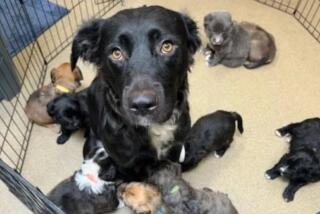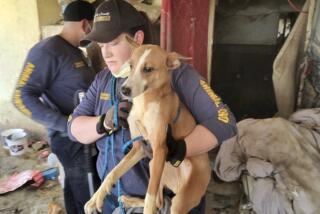21 dogs who ate tree branches to survive are rescued from Ontario home, authorities say
- Share via
Almost two dozen dogs that were so neglected and malnourished they ate tree branches to survive were removed from an Ontario home Wednesday, authorities said.
The 21 dogs — mostly Labrador retrievers and spaniel breeds ages 1 to 13 — were found in “deplorable conditions” in the 3800 block of Antelope Creek Drive, according to the Inland Valley Humane Society and Society for the Prevention of Cruelty to Animals.
The Pomona-based nonprofit had received multiple complaints about conditions at the property, including from neighbors who said the odor was so strong it could be smelled from across the street.
The Humane Society and the Ontario Police Department found nearly two dozen dogs during a search. Because there was no fresh water or food available, the dogs had been eating small tree branches, Humane Society officials said.
“They’re all pretty thin. ... For the most part, they were all lacking the necessary food in their diets,” said James Edward, the organization’s operations manager.
Edward said Thursday the dogs were kept on an average-sized property in a typical single-family neighborhood near an elementary school — “definitely not a ranch.”
The property itself, he said, had “a lot of concrete, artificial turf, makeshift caging system, makeshift fencing” and reeked of feces and urine.
The owner relinquished all the animals to the Humane Society, Edward said.
“We will definitely be pursuing criminal action against this individual through the court system,” he said.
All the dogs will be spayed or neutered, de-wormed, given flea and tick treatments, vaccinated and microchipped, and their individual medical needs will also have to be assessed before they can be put up for adoption, the organization said.
The dogs will need continued “loving care to get them to where they will become more acclimated to being around people,” Edward said.
Prospective owners are “going to have to approach them and treat them like you would a child who has been abused and/or neglected,” he said.
Once the animals are available for adoption, information about each one will be posted on the Humane Society’s website. Edward said anyone considering adding a furry new member to the family should plan on visiting in person.
“When you’re going to pick out an animal that is going to be a part of your family for the rest of its life,” he said, “you want to come down to the shelter that animal is at, interact with it, make sure it’s a good fit with your family.”
More to Read
Sign up for Essential California
The most important California stories and recommendations in your inbox every morning.
You may occasionally receive promotional content from the Los Angeles Times.














